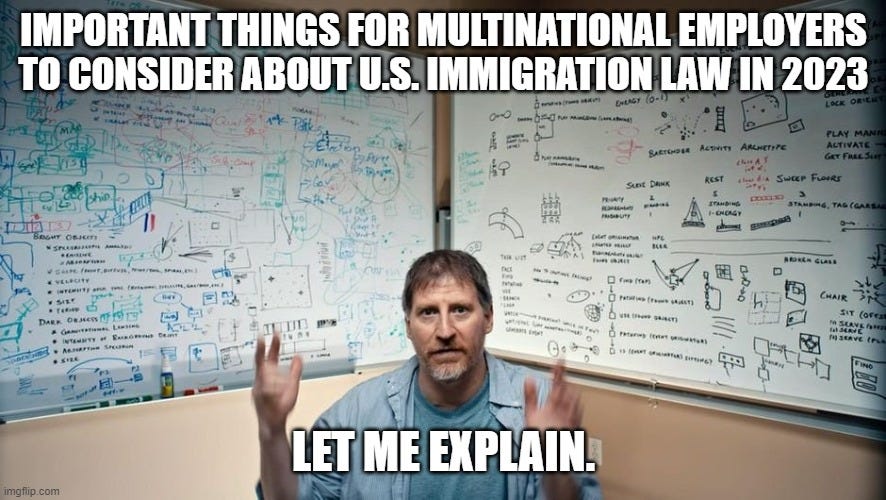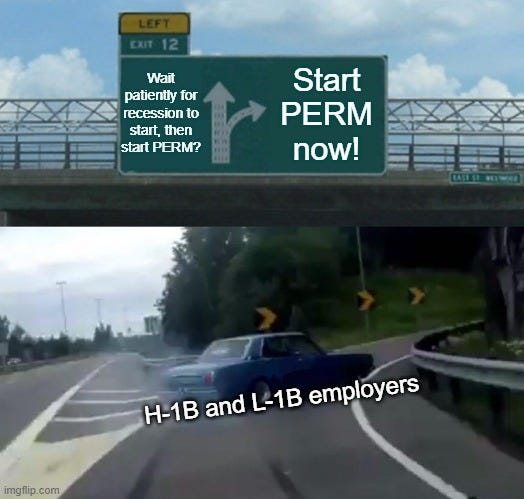U.S. Immigration Law Planning for Multinational Companies in 2023
2023 is upon us. Your 30-day trial has expired. There is no going back. Here are 7 things large companies should know about U.S. immigration law this year.
[That’s not me in the photo by the way].
1-The H-1B Cap Lottery is Going to be a Disaster. Prepare your Disaster Plan now.
The H-1B cap lottery will be conducted in March 2023. The last lottery was run in March 2022 and there were close to 500k registrations for only 85k new H-1B visa approvals. The 500K from March 2022 was up 60% from the year before.
Assuming another 60% increase (which I think is frankly conservative), that means there may be 700K (or more) filings against the same 85K new H-1B visas available.
Organizations and candidates seeking H-1B status in the H-1B cap lottery should recognize the chance of being chosen in the March 2023 is very low and starting thinking about Plan B and Plan C contingencies.
One of our clients recently started the process of transferring a valuable F-1 student to Europe even though we are trying for an H-1B cap case in March. It is her last chance and her STEM OPT will expire in July. Better to have the contingency plan in place and moving ahead than scramble at the last minute.
2-Embrace L-1s. If you don’t have a Blanket, get one. Use it.
Employers with at least 3 or more domestic or non-US subsidiaries, branches, or affiliates, and at least $25 million in U.S. revenue (as documented by a U.S. income tax return) should have a corporate blanket L petition approval. If you are eligible and you don’t have a blanket L, get going on it. Like yesterday!
A corporate blanket L petition approval provides considerable benefits by allowing L-1 candidates to seek L-1 visas directly at the U.S. consulate and skipping the costly and relatively obnoxious adjudication standards of L-1s at USCIS.
L-1 visas provide a considerable advantage to H-1Bs:
No annual limit or cap;
Spouses of L-1s in L-2 visa status can now work easily (including at your company!);
L-1A managers who also served as managers outside the US can potentially transition to EB1C green card cases, which is a particularly attractive immigration route for Indian-born candidates but has appeal to all nationalities given the increase in cut-off dates on the Visa Bulletin for the whole world.
3-PERM is taking forever and some industries have a layoff mess to manage. Start ASAP.
Despite a jobs boom (in many sectors) and an ongoing national labor shortage, the U.S. Department of Labor has record slow processing for 9141 prevailing wage requests (taking 6+ months) and record slow processing for 9089 PERM applications (taking 8+ months). There is no end in sight and processing times could easily get WORSE in 2023. The Secretary of Labor seemingly does not even realize this program is his responsibility.
Separate from the long delays at DOL, some sectors (particularly “Big Tech”) will face added complications for PERM as a result of layoffs and the fairly technical rules potentially limiting PERM filings for employers who have had layoffs.
4-The Visa Bulletin is a Disaster and it is going to get Worse. Start Green Cards for Expats ASAP.
The cut-off dates that have existed since the beginning of time for Indian-born and Chinese-born skilled immigrants have now expanded into all nationalities and it is possible those cut-off dates (backlogs) will grow in 2023.
This will hit employers hard who are used to bringing people over on L-1 visas from Europe or South America and have traditionally delayed starting the green card process. Don’t do that! Start now!
5-Don’t Count on Congress for Relief.
The Republicans now control the U.S. House of Representatives in Washington D.C. and they are committed to immigration as defined almost exclusively by closing the Southern Border. They have a slim majority and a vocal populist faction (as demonstrated by the historic delay in choosing a Speaker of the House).
It is not likely they will be interested in passing any increase in legal immigration options in 2023.
6-Take the Temperature of your Stakeholders - Are they Happy Campers?
Employers with people on work visas should try to find out how happy they are with their immigration programs. Anecdotally I think there is significant frustration with how immigration programs are run at large companies. I think there is more openness to talented foreign national employees to simply leave companies that have dysfunctional or poorly-run immigration programs.
2023 may be a year when certain very large and well-known companies find out that their brand and prestige is not enough to attract top talent when combined with a poorly run immigration program that is slow to respond to concerns of employees or slow to sponsor employees leaving them in perpetual stress and frustration.
7-Review Your Outside Counsel Arrangements - Are you Single Sourced? Is that producing the best outcomes? Do you Control your Employees’ Data?
My small firm had a strong 2022 and among our successes was being retained by two significant employers. These are companies that have hundreds of employees on work visas. I know both companies use multiple law firms for their immigration needs. While I would love to do all the work for both companies, I openly admire the in-house teams at both companies for recognizing the importance of having a diversified base of service providers. I have been open with my own firm’s capacity and we talk transparently on how quickly we can get things done. Do you have these kinds of conversations with your firm? Or are you just waiting for them to do something?
In the same way that the government and companies are struggling with staffing and capacity, it is also true for law firms. I believe the smartest visa-sponsoring employers utilize multiple firms to maximize options. For example:
There might be one firm that is very strong on PERM.
There might be another to use for O-1 and EB-1 outstanding researcher cases.
You might have one division working with one firm and another division working with another firm.
You can compare costs and service on a monthly or quarterly basis without the complexity and hassle of RFPs and moving work wholesale from one firm to another.
For one client, the in-house contact was able to benefit from various perspectives and legal analysis on how the relatively new pay transparency laws impact PERM processing.
Large companies are very comfortable using multiple law firms for employment law or litigation or even corporate transactions, but historically large companies have incorrectly felt that immigration was special and could only be done by one firm. And not surprisingly the one firm getting all the work will keep saying how critical it is for them to do all the work — go figure!)
In-house teams are increasingly sophisticated and they need to be empowered to shop around. I think more and more companies are creating a panel of firms available to handle visas and green cards.
Slightly related, but one thing that large employers need to do is make sure that their employee data is their data, not the data of their law firm. The absolute worst reason I heard recently of a company not wanting to change law firms was because all their employee data was embedded into the proprietary dashboard of their existing law firm, and they dreaded the data migration. They were tolerating low quality service and relatively high rates because they felt trapped.
An employer’s immigration data for its employees should be retained in systems that are non-proprietary or based at the employer (not the law firm). Based on the stories I have heard, there is definitely a Trojan Horse quality to these firms pitching their proprietary solutions.
.









